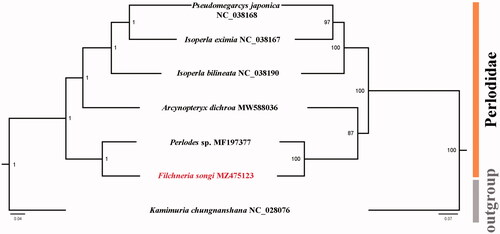Abstract
The complete mitochondrial genome of the perlodid stonefly, Filchneria songi Chen, Citation2019 was sequenced and analyzed. This double strand, circular molecule is 16,028 bp in length with an A + T content of 70.1%, and contains 13 PCGs, 22 tRNA genes, and two rRNA genes. A 1099-bp long control region was detected, with a high A + T content of 81.9%. Gene arrangement was conserved in the mitogenome of F. songi. Most PCGs use standard start codons and ended with complete stop codons. The phylogenetic analysis supported that F. songi was closely related with species of Perlodes Banks, Citation1903.
Filchneria songi Chen, Citation2019 (Plecoptera: Perlodidae) is an endemic stonefly known from Shaanxi Province of China. However, very few genetic information is available for F. songi, which is unfavorable for the resolution of phylogeny in Perlodidae. To provide more molecular data for F. songi, we sequenced and analyzed the complete mitochondrial genome (mitogenome) of this stonefly as the first representative for genus Filchneria Klapálek, Citation1908. A phylogenetic analysis was also performed to confirm its position in the family Perlodidae. The specimens of F. songi were collected from Taiping National Forest Park, Xi’an City, Shaanxi Province, China (33.9077 N, 108.6513 E, 1200 m) in April 2019. All specimens and DNA samples were stored in the Insect Collection of Jiangsu University of Science and Technology (ICJUST, Zhi-Teng Chen, [email protected], under the voucher number ICJUST-PO1), Jiangsu Province, China. The sequencing strategy followed that of Chen and Du (Citation2018), including an initial amplification of the large and small ribosomal genes (rrnL and rrnS), cox1 and cox2 genes, followed by LA-PCR amplifications which obtained two overlapping fragments covering the whole mitogenome. The PCR fragments were sequenced in Map Biotech Company (Shanghai, China). Structural and phylogenetic analyses also followed that of Chen and Du (Citation2018). The mitogenome sequence of F. songi was deposited in GenBank with the accession number MZ475123.
The complete mitogenome of F. songi has a length of 16,028 bp and contains an A + T content of 70.1% (A: 36.5%, T: 33.6%, C: 18.0%, G: 11.9%). A typical set of 37 genes (13 PCGs, 22 tRNA genes, and two rRNA genes) and a long non-coding control region were annotated. The control region was located between rrnS and trnIle, 1099 bp in length with an A + T content of 81.9%. The gene rearrangement of F. songi is highly conserved among stoneflies.
Most PCGs started with the standard start codon ATN (ATT and ATG), whereas ND1 initiated with TTG. Most PCGs terminated with the complete stop codon TAA or TAG, whereas COX2 and ND5 ended with an incomplete codon T. The 22 tRNA genes varied in length from 59 bp to 71 bp, mostly showing clover-leaf secondary structures except for trnSer1 (AGN) and trnTyr, which showed reduced tRNA arms. The two rRNA genes, rrnL and rrnS are found in the conserved locations as in other stoneflies. The rrnL gene was 1333 bp in length with an A + T content of 73.7%; the rrnS gene was 797 bp in length with an A + T content of 68.3%. There were 33 overlapped nucleotides between nine gene pairs with the longest overlap between trnTrp and trnCys. A total of 130 intergenic nucleotides were found between 13 gene pairs, with the longest intergenic sequence between COX2 and trnLeu2 (UUR).
Phylogenetic analyses for Perlodidae were performed using the concatenated nucleotide sequences of 13 PCGs. The BI and ML trees generated identical topologies (). In both trees, F. songi sequenced in this study is supported as the sister group of Perlodes sp., another species from family Perlodidae. The monophyly of genus Isoperla Banks, Citation1906 was not supported by the mitogenomic data. The taxonomy of Isoperla was also considered controversial due to the loss of most holotypes (Chen et al. Citation2021). More molecular data including mitogenome data are required to solve the molecular phylogeny of Perlodidae.
Figure 1. Phylogenetic tree of six species of Perlodidae. Numbers at the nodes are posterior probabilities of BI analysis (left value) and bootstrap values of ML analysis (right value). The GenBank accession numbers are indicated after the scientific names. The tree is rooted with Kamimuria chungnanshana (Perlidae, NC_028076).

Disclosure statement
No potential competing interest was reported by the authors.
Data availability statement
The genome sequence data that support the findings of this study are openly available in GenBank of NCBI at https://www.ncbi.nlm.nih.gov under the accession no. MZ475123.
Additional information
Funding
References
- Banks N. 1903. New name for Dictyopteryx Pictet. Ent News. 14:241.
- Banks N. 1906. On the perlid genus Chloroperla. Ent News. 17:174–175.
- Chen ZT. 2019. A new species and a new record of Perlodidae (Plecoptera) from China. Zootaxa. 4623(1):189–200.
- Chen ZT, Du YZ. 2018. The first two mitochondrial genomes from Taeniopterygidae (Insecta: Plecoptera): structural features and phylogenetic implications. Int J Biol Macromol. 111:70–76.
- Chen ZT, Du SK, Li XT. 2021. Description of a remarkable new species of Isoperla (Plecoptera: Perlodidae), with supplements for Isoperla kozlovi Zhiltzova, 1972 from China. Zootaxa. 5027(2):160–174.
- Klapálek F. 1908. Pteronarcys sachalina sp. n., die zweite asiatische Art der Gattung. (Neuroptera, Plecoptera). Bull l’Acad Imperial Sci. 2(3):237–238.
